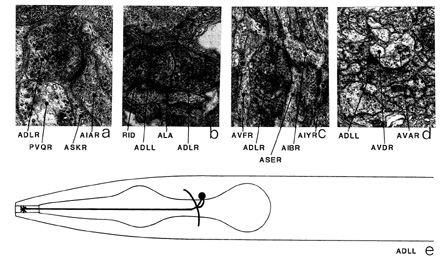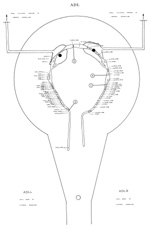ADL is a set of two neurons that have dual ciliated endings in the amphid sensillum. The endings are in the amphid channel, which is open to the outside (figure 1). Cell bodies are situated in the dorsal regions or the lateral ganglia and have processes that enter the nerve ring laterally, unlike the other amphid neurons, which enter the ventral cord via the amphidial commissures. The processes split as they enter the nerve ring and one process runs dorsally round to the mid-line on the posterior face of the nerve ring, where it meets its contralateral partner and terminates with a gap junction (b). The other process runs ventrally and eventually peters out in the ventral ganglion. The general disposition of the processes in the nerve ring is much like those of the other amphid neurons (such as ASK, alongside which it runs for much of its length) yet the route from the cell body is completely different. The processes are large; they run in close association with those of AIB and are filled with vesicles, many of which are dark-cored (a). The processes are predominantly presynaptic, synapsing mainly onto AIA (a) and AIB (c) and to a lesser extent onto AVD, AVB and AVA (d). There are gap junctions to OLQ and RMG. Magnifications: (a) x 25500, (b-d) x 12750.

Click pictures for higher resolution images


